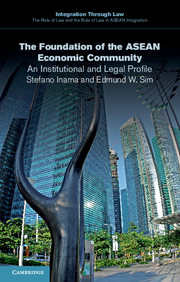1 - Introduction
Published online by Cambridge University Press: 05 May 2015
Summary
This book provides a critical overview of the efforts of the Association of Southeast Asian Nations (ASEAN) in its ASEAN Economic Community (AEC) project and the existing agreements and institutional tools available to ASEAN in constructing the AEC. The focus is on the intra-ASEAN foundations of the AEC, examining both the language and substance of the underlying agreements, as well as the institutional arrangements currently in place.
A necessary premise to the introduction of this book is that the ASEAN Charter and the related ASEAN agreements and protocols are examined in the light of their objectives of achieving economic integration, more specifically a single market and a single production base according to the objectives of the ASEAN Charter.
It has to be recognized that trade and economic integration was not a founding pillar of ASEAN. The Bangkok Declaration of 1967 establishing ASEAN was focused on political and diplomatic cooperation in Southeast Asia, in the context of the Cold War. However the fact that objectives of economic integration are becoming an important aspect of ASEAN and are explicitly included in the ASEAN Charter, adopted forty years later in 2007, demands a revisiting of the ASEAN instruments to assess whether ASEAN has matched economic integration objectives with the necessary means to achieve them.
Single market and single production base: prioritizing
The attitude of Asia toward regional trade integration may be best summarized by the motto “Where markets lead, governments are following.” Indeed Southeast Asian perception and political impetus toward trade integration has always been geared by de facto market integration rather than formal trade integration understood as trade agreements and free trade areas. This is somewhat different from European and North American experiences where governments took the lead in designing the Treaty of Rome of 1957 in Europe and its most recent successor, the Lisbon Treaty for the formation of the European Union (EU), and in the North American Free Trade Agreement (NAFTA) of the United States, Mexico, and Canada.
- Type
- Chapter
- Information
- The Foundation of the ASEAN Economic CommunityAn Institutional and Legal Profile, pp. 1 - 18Publisher: Cambridge University PressPrint publication year: 2015



